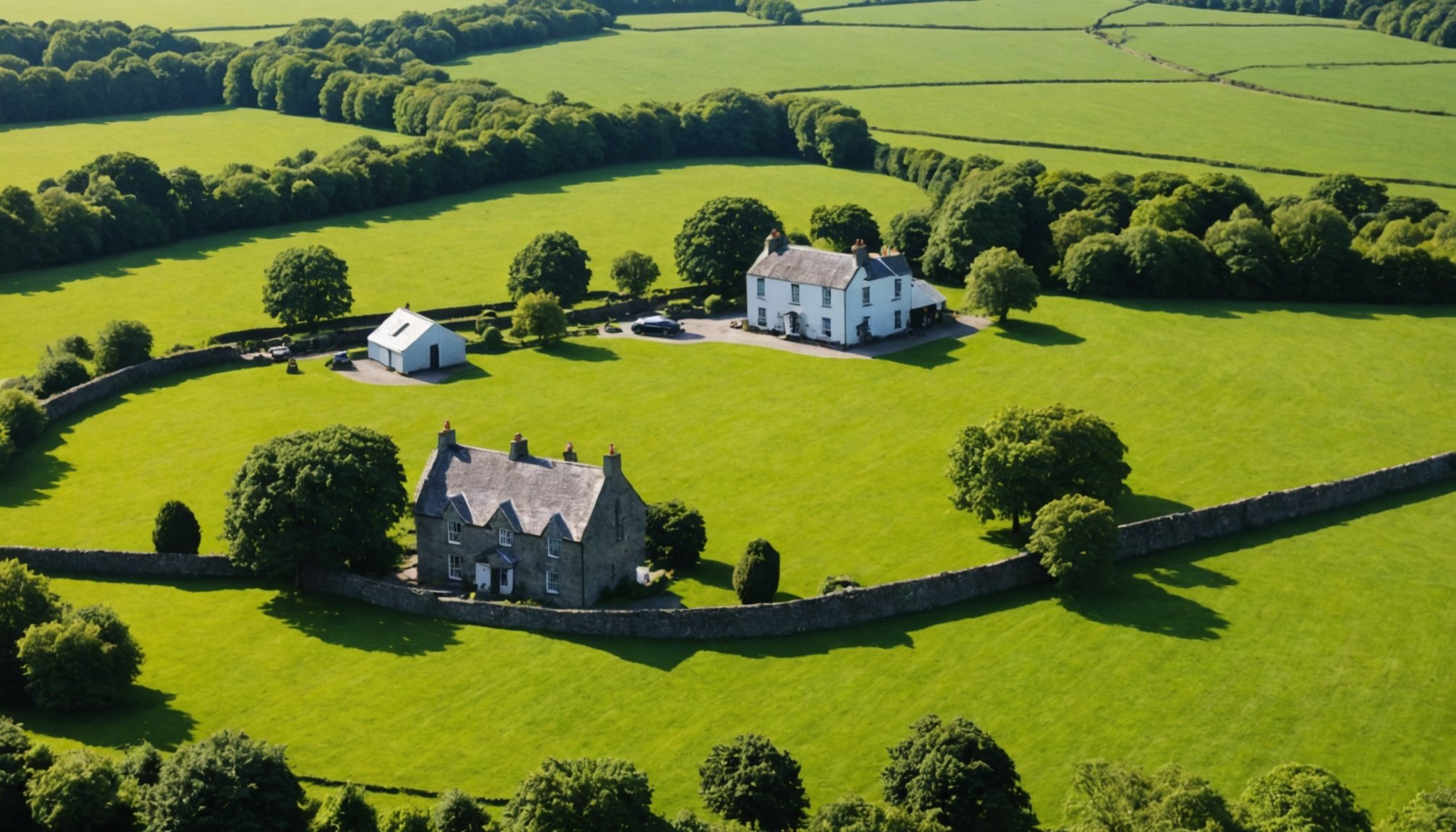Overview of Rural Estate Management in Northern Ireland
Rural estate management in Northern Ireland plays a pivotal role in maintaining the balance between development and conservation across its unique landscapes. This practice involves overseeing the use and maintenance of land and natural resources, ensuring sustainable productivity while preserving ecological integrity.
Northern Ireland is dotted with charming rural estates that boast rolling hills, lush pastures, and protected natural habitats. These areas are not only habitats for diverse wildlife but also support agriculture, renewable energy, and tourism. The combination of these activities requires adept management to maintain the land’s biodiversity and productivity.
A voir aussi : Essential Insurance Guidelines for Thatched Roof Homes in Devon: What You Need to Know
The significance of land management in this context extends beyond environmental stewardship. Rural estates considerably contribute to the local economies, often acting as hubs for employment and cultural heritage. Their management includes balancing historical conservation with modern-day requirements such as supporting rural tourism and sustainable agriculture.
Rural estate managers in Northern Ireland face the challenge of integrating economic development with ecological preservation. Professionals in this field must be knowledgeable about both legislative frameworks and practical management strategies. By efficiently managing these lands, they help ensure economic vitality in rural communities while preserving the scenic beauty and environmental health that define Northern Ireland’s rural charm.
A lire aussi : Mastering Property Auctions: The Ultimate Bidding Strategies for Success in Liverpool
Key Challenges in Rural Estate Management
Managing rural estates seamlessly requires grappling with several intricate challenges. These challenges are inherently tied to estate management, where understanding the interplay between law, environment, and societal needs is critical.
Navigating Complex Legal and Regulatory Frameworks
Legal complexities in rural estate management stem from diverse land regulations that vary widely across regions. Owners and managers must maintain an updated understanding of legal requirements to ensure compliance, ranging from zoning laws to property rights. These regulations can often change, requiring continuous education and adaptability.
Environmental Sustainability and Biodiversity Concerns
Addressing environmental issues stands at the forefront of rural estate management. Maintaining biodiversity while promoting sustainable practices calls for strategic planning. Mitigating actions include careful monitoring of land management practices and integrating conservation efforts that support ecosystems.
Managing Land Use Conflicts and Agricultural Pressures
Land use conflicts often arise when competing interests, such as agriculture, recreational use, and conservation, collide. Balancing agricultural pressures with environmental needs necessitates open dialogue and negotiation among stakeholders to arrive at mutually beneficial solutions. Land managers need to be adept at conflict resolution to maintain harmony and optimize land use.
By understanding these challenges, rural estate managers can implement strategies that align with sustainable practices, legal compliance, and community engagement, ultimately fostering a balanced approach to land stewardship.
Best Practices for Effective Rural Estate Management
Effective rural estate management hinges on both traditional and modern approaches. At its core are sustainable land management techniques, crucial for preserving natural resources and promoting environmental health. Practices such as crop rotation, agroforestry, and the use of organic fertilizers not only enhance soil fertility but also combat erosion and reduce the environmental footprint of rural estates.
Another cornerstone of successful estate management is community engagement. By involving local communities and stakeholders in decision-making processes, estate managers ensure that the strategies align with the local needs and dynamics. This collaboration fosters a sense of ownership and shared responsibility, leading to better compliance and long-term success.
Modern technology plays a transformative role in this field. Tools such as drones for aerial surveys, remote sensing for real-time data collection, and Geographic Information Systems (GIS) for mapping and analysis are now integral to estate management strategies. These technologies enable managers to monitor vast areas efficiently, identify issues early, and make informed decisions that enhance productivity and sustainability.
By prioritizing sustainability, embracing technological advancements, and actively involving local communities, rural estate managers can create resilient and productive environments. These best practices not only ensure the longevity of the estates but also contribute to the overall well-being of the community and environment.
Case Studies of Successful Rural Estate Management
Explore effective rural estate management through detailed case studies. These examples provide insights into the unique strategies that have made estate management successful and sustainable.
Case Study 1: Innovative Land Use Strategy
In this enlightening case study, we examine a rural estate’s transformation through an innovative land use strategy. The estate implemented a rotational grazing system to optimise productivity while maintaining ecological balance. This approach enhanced the health of grasslands, increased livestock output, and reduced soil erosion. The success of this strategy lies in its adaptability and the measurable improvement in environmental sustainability.
Case Study 2: Community Engagement in Estate Management
This case study highlights the pivotal role of community engagement in successful estate management. Through active collaboration with local residents, the estate improved trust and support for sustainability initiatives. Regular workshops and feedback sessions ensured that the community’s needs were aligned with estate objectives, leading to shared success. The proactive involvement of community members was fundamental in driving innovative management practices.
Case Study 3: Balancing Conservation and Productivity
This study explores the delicate balance between conservation and productivity in estate management. An estate adopted integrated farming techniques, allowing for both agriculture and wildlife preservation. By implementing biodiversity corridors, the estate maintained habitats while achieving substantial agricultural yields. This balanced approach demonstrated that conservation efforts could coexist with productive management, setting an example for others to follow.
Policy Recommendations for Improving Rural Estate Management
Implementing effective policy recommendations is crucial for advancing rural development and enhancing estate management. Key to this is establishing supportive governmental policies and frameworks. Governments should set up regulations that encourage and facilitate sustainable farming practices, addressing environmental concerns while balancing economic growth.
To further rural development, financial incentives are indispensable. By providing tax benefits or subsidies, governments can motivate landowners to adopt sustainable and innovative practices. For example, implementing eco-friendly technologies or practises considered to have a higher initial cost can become more attractive when offset by financial rewards.
Another vital aspect is fostering collaboration. Landowners, government bodies, and NGOs must work hand in hand. By sharing knowledge and resources, these stakeholders can devise more efficient solutions to common problems like land degradation, water scarcity, and biodiversity loss. Collaboration can lead to the sharing of best practices and innovative strategies, amplifying their positive impacts across larger areas.
Together, supportive policies, financial incentives, and collaborative efforts form a robust framework to propel rural estate management towards a more sustainable and prosperous future. These approaches foster an environment conducive to positive changes that benefit landowners, communities, and the environment.
Resources and Tools for Estate Managers
In today’s digital era, estate managers have access to a plethora of tools for estate management that streamline operations and enhance efficiency. Advanced software solutions offer features like inventory management, scheduling, and communication to maintain seamless estate functions. It’s vital to explore various tools to fit specific estate needs, ensuring a tailored approach that aligns with management strategies.
Embracing resources and technology is pivotal in keeping up with the dynamic demands of estate management. Learning platforms provide training resources and educational programs, allowing managers to upskill and stay informed about industry trends. These resources often include online courses, webinars, and tutorials designed to bolster knowledge and practical skills, ensuring estate managers operate at the top of their game.
The role of networking and support groups cannot be understated. These platforms fortify professional connections and facilitate knowledge sharing among estate managers. Engaging in such groups offers insights into best practices and innovative solutions, enhancing decision-making processes. Additionally, being part of a supportive community acts as a safety net, providing valuable support when faced with unique challenges.
Overall, leveraging technology and resources, along with strong networks, can significantly boost the proficiency and effectiveness of estate managers in handling complex responsibilities.











